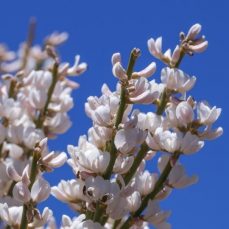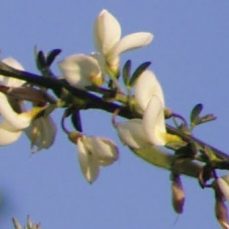White Spanish Broom
Cytisus multiflorus

Vectors of Spread:
Synonyms
White Broom, Portuguese Broom
ID Characteristics
Flowers: Small, pea-like, white flowers with a pink streak at the base. White Spanish Broom flower are about 1 cm long and have 5 petals.
Stems: Young stems and leaves are covered in short hairs, which fall off as the plant ages. Stems are five-angled, flexible, and striped, forming “broom-like” formations. Shrubs can be up to 3 m tall.
Leaves: The leaves are arranged in groups of three leaflets on lower branches and a single leaflet on higher branches. Each leaflet is small, under 1 cm long. Leaflets are generally oblong.
Seeds: Resemble pea pods. The seed pods are covered with short hairs and are generally 15 – 27 mm long and 4 – 7 mm wide. The pods turn black when mature and release seeds explosively when ripe. Each pod contains 3 – 7 seeds, which are 2.5 – 3.0 mm long and olive to brown in colour.
Similar Species
Invasive:

Scotch Broom (J. Leekie)
Scotch Broom (Cytisus scoparius) can be found throughout the Sea to Sky corridor. White Spanish Broom has finer, greyer foliage than Scotch Broom, and unlike White Spanish Broom, Scotch Broom flowers are yellow and sometimes yellow and red.

Spanish Broom (B. Brett)
Spanish Broom (Spartium junceum) is not currently found in the Sea to Sky corridor. Unlike White Spanish Broom, Spanish Broom flowers are yellow. Spanish Broom stems are round, whereas Scotch Broom stems are ridged.
Report
Please report any sighting of White Spanish Broom by clicking here.
Habitat and Origin
As its name suggests, White Spanish Broom is native to Europe, specifically France, Spain, and Portugal.
Little is known about the habitat requirements of White Spanish Broom. It appears to spread to disturbed and undisturbed areas, from roadside sites to grasslands and open woodlands in temperate regions.
Current Distribution

Propagation & Vectors of Spread
White Spanish Broom reproduces by seed. Similar to Scotch Broom, the White Spanish Broom seeds are believed to remain viable in the soil for several decades, causing the rapid formation of a long-lived seedbank. White Spanish Broom infestations can also spread through stem pieces taking root.
Most White Spanish Broom seeds fall near the parent plant. However, longer-distance dispersal can happen by movement of seed by water, or in mud attached to vehicles, machinery, footwear, or animals. Seeds and stem pieces may also be dispersed in dumped garden waste.
Ecological, Economic, & Health Impacts
Ecological:
- Dense thickets create fire hazards.
- Impedes the movement of wildlife
- Outcompetes and displaces native species, reducing biodiversity
- Outshades conifer seedlings.
- Can fix nitrogen in the soil, which increases soil fertility and gives a competitive advantage to other non-native weeds that thrive on high nitrogen levels.
Economic:
- Obstructs sightlines on roads, railways, and utility right-of-ways, resulting in increased maintenance costs for removal.
- Reduces forage for livestock, resulting in reduced production.
What Can I Do?
White Spanish Broom is found in the Sea to Sky region, but with a limited distribution. The goal is to eradicate this species from the region, and to prevent new introductions.
Learn to identify White Spanish Broom: use the images presented on this profile page to learn how to identify White Spanish Broom.
What to do if you spot it: You can report any White Spanish Broom sightings by clicking here.
DO:
- Regularly monitor properties for weed infestations.
- Minimize soil disturbances and promptly revegetate disturbed areas to prevent the growth of White Spanish Broom.
- Ensure all flowering heads or buds are bagged or covered to prevent spread during transport to designated disposal sites.
- Ensure soil and gravel are uncontaminated before transport.
DO NOT:
- Unload, park or store equipment or vehicles in infested areas; remove plant material from any equipment, vehicles or clothing used in such areas and wash equipment and vehicles at designated cleaning sites before leaving infested areas.
- Plant White Spanish Broom in a garden, no matter how well-contained its enclosure may seem.
- Compost any flowering heads or buds. Instead, dispose of White Spanish Broom in the general/household waste stream at the landfill as the seeds will be able to persist the composting process.
- Move soil, gravel, or fill that has been contaminated with White Spanish Broom.
Control
Mechanical
- Small seedlings (less than half a pencil width) can be pulled when the soil is moist.
- Larger plants must be cut down at the base of the stem before they begin to flower.
- Due to White Spanish Broom’s need for sunlight to photosynthesize, covering the newly cut stem with soil, moss or plastic will help prevent regrowth.
Chemical
- Commonly-used herbicides include triclopyr, imazapyr, aminopyralid, and glyphosate applied alone or in combination with 2,4-D.
- Herbicides can be applied from spring to late summer using selective spot spraying, basal stem injection, or cut surface application.
We recommend that any herbicide application is carried out by a person holding a valid BC Pesticide Applicator Certificate. Before selecting and applying herbicides, you must review and follow herbicide labels and application rates; municipal, regional, provincial and federal laws and regulations; species-specific treatment recommendations, and site-specific goals and objectives.
Biological Control
- Grazing with goats or sheep is suitable for pasture, especially on new growth.
References
- CABI, Chamaecytisus albus (White Spanish Broom), https://www.cabidigitallibrary.org/doi/10.1079/cabicompendium.113178
- California Invasive Plant Council, Cytisus multiflorus, https://www.cal-ipc.org/plants/profile/cytisus-multiflorus-profile/
- Dave’s Garden, Cytisus Species, White Spanish Broom, https://davesgarden.com/guides/pf/go/79474/#b
- Global Biodiversity Information Facility, Cytisus multiflorus, https://www.gbif.org/species/7681436
- Government of Australia, Cytisus multiflorus https://profiles.ala.org.au/opus/weeds-australia/profile/Cytisus%20multiflorus
- UC Berkeley Jepson eFlora, Cytisus multiflorus SPANISH or PORTUGUESE BROOM, https://ucjeps.berkeley.edu/eflora/eflora_display.php?tid=22197
- US Department of Agriculture, Cytisus multiflorus (L’Her.) Sweet, https://plants.usda.gov/core/profile?symbol=CYMU3
- Royal Horticulture Society, Cytisus multiflorus, https://www.rhs.org.uk/plants/73325/Cytisus-multiflorus/Details
















